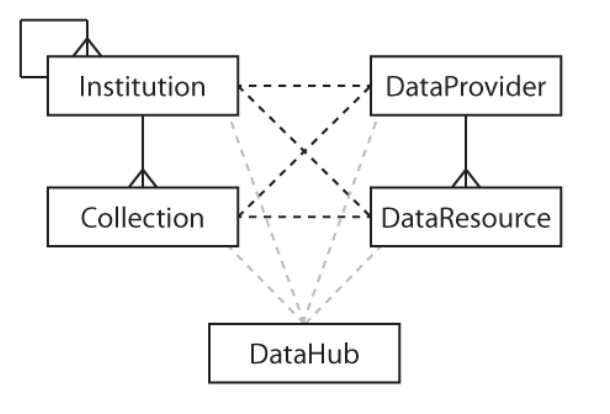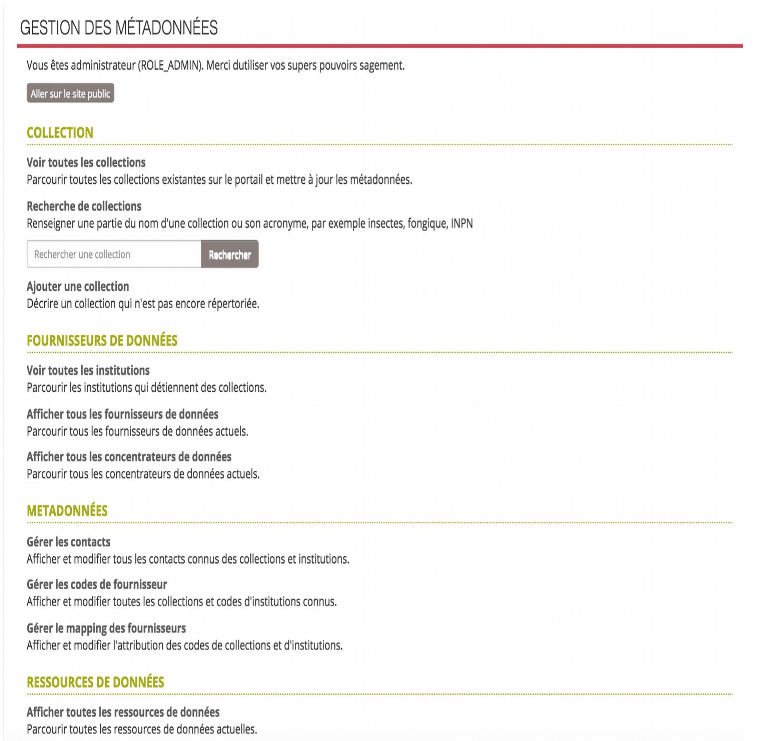Resume - AtlasOfLivingAustralia/documentation GitHub Wiki
A Living Atlas collectory maintains metadata that describe:
- collections: natural history collections;
- institutions: institutions and organisations that manage collections;
- dataProviders: providers of biodiversity information in electronic form, eg occurrence records, websites;
- dataResources: specific resources made available by data providers;
- tempDataResources: temporary resources holding records uploaded to the sandbox;
- dataHubs: aggregators of biodiversity data; and
- contacts: for any of the above resources.
There are two type of data here: those who are added by the administrator, and those who are objects created by the GBIF.org (objects contained in some IPT).
One of the administrators rights is to upload data on LA portal; there are different types :
- Metadata: collections, institutions, data providers, data hubs, contact, data resources
- Configuration data: providerCode, providerMaps
- Occurrence: Resource (including GBIF data resources)
You will find below a schema showing how the data type works together.
- One Institution can have many Collections.
- One Collection belongs to just one Institution
- One Data Provider can have many Data Resources, many Collections or many Institutions.
- One Data Resource can have one or more Institutions and one Data Provider but can be link to many Collections and many Institutions.
- One Data Hub can have many Collections, Institutions and Data Resources.
These links are all optional - some Living Atlases are not using Data Providers - LAs which are largely connecting specimen data, and similarly some Living Atlases which are largely observational aren't using Institutions…
Type of data
The addition of these elements in the collectory service is carried out via the administration pages so, the first step is to login (something like https://collectory.l-a.site/admin) in order to see it. The figure below is is the customization made by GBIF France but you will be able to see the same menu.
You can add a collection directly from this page using the "Add collection" link. For the other objects, you will need to go by the “See all [name_Object] “ page. A link “Add [name_Object]” will be display and will lead you to the add form of the object.
Collection
To create a new collection, either you go with the “Add a collection” on the administration page or on the visualisation page of Collections; or you can create a collection when you create a new data provider.
Data provider
A data provider can be an institution or a data Hub; an institution is a Museum, a particular, a private or public collection; a data hub is a structure that have multiple data.
Institution
To create a new institution, information will be requested among which: Site collection, description, type, collections, logo, location, related data providers, contacts, etc.
Data Hub
To create a data hub, you need to add basic informations as name, url, etc. but you also need to specify collections, institutions and data resources link to this Hub. For more configuration and how it works, we invite you to read the chapter about the architecture.
Contact
You can create contact directly on the menu dedicated to them but you can also create contact when you create an institution, a collection, a data provider or a data hub.
You can also add role to a contact, it is an open variable so you can add what you want and then you can say if you want him to manage the resource, if you want him to be inform by any annotation made on his occurrence and if this contact is the primary contact of the resource. If yes, you will see the name on the public page.


